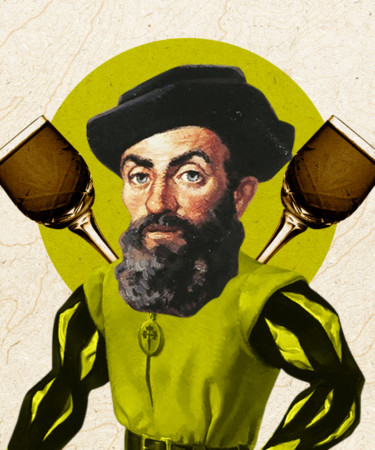Circumnavigating the globe in search of new lands is a feat within itself; it’s no wonder explorers didn’t do it sober. Luckily, Ferdinand Magellan thought of this before setting off in 1519 in search of passage to Asia via the Pacific Ocean. That was the year that the famed Portuguese explorer packed up five ships and 270 crew members — along with enough sherry and wine to replenish everyone on board for the long journey ahead.
This was common during the Age of Exploration, seeing as wine could be stored and consumed over long periods of time ao long as it was stored properly (most often in pipes, casks, and wooden barrels). Documents from Magellan’s expedition cite a hefty 203 butts (barrels) and 417 wineskins — from the Jerez wineries in southwest Spain’s Andalusia region — made it onboard. Today, this amounts to nearly 243,000 liters of booze.
Magellan and his crew must have really needed the extra liquid luck on the expedition, seeing as the cost of wine and other provisions amounted to 1,585,551 maravedis. Taking inflation and conversions into account, Magellan brought about $475,665 worth of booze on board. Researcher and crew member Navarrete noted in Document No. XVII that this number accounted for 20 percent of all costs on board.
While this cargo might seem like an odd choice to bring on such a perilous journey, Magellan was not the only explorer to favor wine on board. Christopher Columbus packed his ships with sherry from those same Jerez vineyards. Since ancient times, the Phoenicians traversed the oceans with wine and sherry, and explorers across Europe and the old Ottoman Empire would follow suit. Trading wine to other cultures and civilizations proved to be economically beneficial, and aging barrels in moving water proved to double a supply’s flavors and maturity levels.
But by the late 1400s and early 1500s, this global wine market declined. It was during this time that the south of Spain became known as the “sherry triangle,” as the region fought for a spot in the new market. Since the country sponsored and paid for Magellan’s travels west, barrels of the product were placed on board. (Magellan’s previous trips were chartered by Portugal as he was born and raised there, but he renounced his citizenship in 1517 prior to the 1519 journey).
Jerez served as a symbol of Spanish wine, made with Palomino and Pedro Ximenez grapes. As the Spanish began to explore new lands, they brought this emblem of the nation with them on the journey. Seeing the opportunity for new trade, Spain jumped to rid the export taxes on wine traveling from Spanish or foreign ships, allowing for the world to indulge in its homegrown barrels.
When Magellan and crew embarked on their long, perilous trek in search of a western route to Southeast Asia’s Spice Islands, they encountered treacherous high seas, opposing ships, and headstrong leaders. Still, an assessment of the ships’ cargo found that Magellan spent 3,912,241 maravedis on rigging, artillery, and arms, meaning that each of his five ships had just 782,000 maravedis worth of weapons on board. Yes, Magellen spent more on sherry than armaments.
Unfortunately, sherry may in part be blamed for Magellan’s demise. Perhaps it was because, with all that wine on board, the crew lacked the necessary armaments for a possible attack. Maybe Magellan’s consumption of the sherry proved to be less “liquid luck” and more a distraction. Either way, the explorer met his fate on the island of Cebu in the Philippines. So close to the Spice Islands, Magellan worked closely with locals in an attempt to convert them to Christianity. To gain their trust, Magellan’s crew teamed up with the locals as Magellan himself led an attack against a neighboring community. The explorer was killed in battle on April 27, 1521.
As a result, Magellan’s legacy surpasses circumnavigating the globe or even having a strait named after him. He also spread Spanish and Portuguese culture, religion, and wine across the world. Author Pigafetta writes in the “Journal of Magellan’s Voyage” that the first Catholic Mass was held in the Philippines just weeks before the explorer’s death. And you can bet that they celebrated afterward with a couple barrels of sherry.
We’ll raise a sailors’ toast to that.
